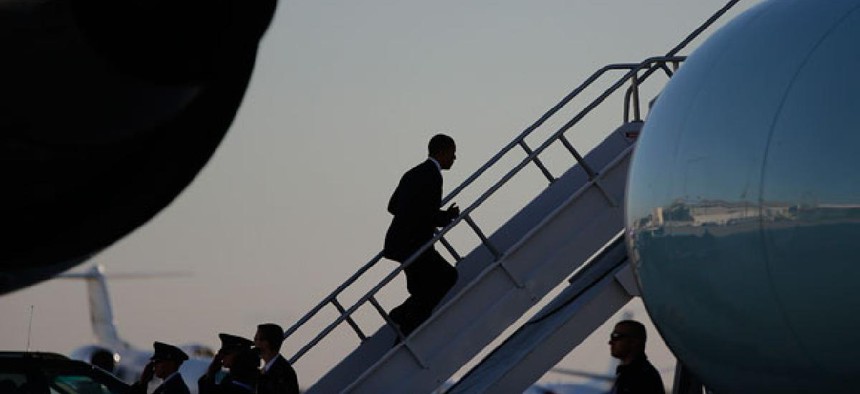
Pablo Martinez Monsivais/AP
The Obama campaign believes in taking its message to the American people. But history shows that, when it comes to the tough issues, use of the bully pulpit can backfire. As Congress faces its toughest negotiating challenge yet, the next president may want to consider keeping a low profile.
The bully pulpit can work when a president takes advantage of a groundswell of public support that already exists. But when a president takes a high-profile stance on a controversial issue, it makes it harder for the opposing party to support his plan.
“When you raise the profile of the issues, you also raise the political stakes for members of Congress on both sides of the aisle. It makes it harder for the members of your own party to oppose you, but it makes it harder for members of the opposite party to support you,” said Frances Lee, professor of American politics at the University of Maryland.
President George W. Bush launched his second term with a very public push for Social Security privatization. He got nowhere. In fact, public support declined, Lee said.
“We determined that if we were going to have a chance to get Social Security reformed it was not going to be the kind of thing that we could just get done, quietly, in Congress,” said Tony Fratto, a partner at Hamilton Place Strategies and former communications adviser in the Bush White House. The Bush team believed that the public first needed to learn why privatization made sense, Fratto said.
“My instinct would always be to go out and try to educate more” when it comes to complicated issues, Fratto said. But he admitted that an aggressive communications strategy on such issues hasn’t had the best track record.
President Clinton campaigned all around the country to try to raise support for his health care plan and failed. The Obama White House tried everything from speeches and town hall meetings to blog posts and tweets to try to rally the public around health care reform. The law—which was based on what were initially Republican ideas—was rammed through Congress on a party line vote. Democrats love it. Republicans despise it.
President Reagan, remembered as “the great communicator,” had the benefit of a cross-party coalition in Congress that no longer exists, Lee said.
Reagan also picked his spots carefully, preferring to negotiate with Democrats before heading out on the road. One of his favorite quotes was, “When you can't make them see the light, make them feel the heat.”
After 2011’s debt-ceiling debacle, President Obama decided to take his message out into the country. “His conclusion was that if we’re gonna move the ball forward, we’re gonna do it by galvanizing the American people, not by trying to cut deals in quiet rooms,” senior adviser David Axelrod told New York magazine earlier this year.
Obama held rallies across the country to call for extending the payroll-tax cut, keeping the interest rate on student loans low, and raising taxes on the wealthy. The White House says those efforts paid off.
“Getting things through this Congress that enjoy broad public support but which are opposed by a particularly powerful wing of the Republican Party, especially in the House, requires taking it to the people,” press secretary Jay Carney said in July.
Some Democrats believe that Obama may use the same approach if reelected, The New York Times has reported, using the bully pulpit to raise the public profile of his plan for deficit reduction. The White House has long maintained that the president’s “balanced approach” to reducing the deficit has broad public support.
That could be a risky strategy. If Obama is reelected, it’s likely to be by a razor-thin margin. He won’t have much of a mandate, and after a year of election-year campaigning the country will be weary of rallies.
He’ll also be giving voice to a more controversial set of proposals. Nobody wants their student-loan payments or their taxes to rise. Selling lower spending on entitlements or tax increases -- the framework for deficit reduction the president has floated -- is much harder.
Presidents are still expected to use the bully pulpit. A president’s words give members of his party cover for difficult votes, and the public expects the leader of the free world to, well, show some leadership. And as The Washington Post’s Ezra Klein pointed out in The New Yorker, “back-room bargains and quiet negotiations” can fail, too.
After the election, Washington faces its biggest negotiation challenge yet. Memories of 2011’s disastrous debt-ceiling negotiations and failed attempts to avert sequestration are on everyone’s mind as Congress prepares to find a way to avoid the end-of-year spending cuts and tax increases known as the fiscal cliff.
The pressure to reach a compromise may be more intense this time around. But when Congress returns after the election, the political theater will resume, and the parties may end up even further apart.






